Algorand and the blockchain trilemma - Crypto Academy / S5W4 - Homework post for nane15
Hello guys, good having you all again in my blog. Let's get started as I engage you on task as presented by Prof @nane15 on Algorand and the blockchain Trilemma.


What is Algorand blockchain?

The Algorand Blockchain
Algorand Blockchain is a new Blockchain creation that is observed to solve the issue of Blockchain Trilemma in the Cryptocurrency space. Before the emergence of the Algorand Blockchain, the Blockchain space has continued to be limited with what we know as Blockchain Trilemma where it is unable to carry out or solve the three (3) essential components that make up the Blockchain which is namely the decentralization, Security, and Scalability.
They have always been the case of majoring on two at the expense of one being inefficient enough like the efficient two. Most likely we see most Blockchain having their strongholds on the decentralization components which is the mainstay of every Blockchain system as well as the security feature which is a guarantee that investors can be assured their assets are secured. Hence the scalability which poses no serious challenge is found wanting.
The concept of Algorand Blockchain, which was developed by professor Silvio Micali, came up with the thriller that delivered the core parameters of any given Blockchain technology (Decentralization, Security, and Scalability). This was leverage for the Algorand Blockchain vis-a-vis other existing Blockchain technology as the Algorand emergence came with a tremendous improvement on the scalability feature which has been a deficient feature in most existing Blockchains.
For the developer of Algorand Blockchain, the recent world of cryptocurrency are savy for the faster transaction which entails that information can be added, shared in the network, and as well carry out verification and validity of data. In his belief, the Blockchain should be able to scale at least like the centralized system where for instance the credit payment system scale-up between 16,000 to 40,000 TPS.
The Algorand Blockchain uses the Pure Proof of Stake (PPoS) to validate and verify transactions in the ecosystem. It uses validators just like what is obtainable in the PoS Consensus mechanism of Ethereum but in this case a little advanced or decentralized in its protocol as more power is given to all participants with the little requirement. In selecting validators on who next to create a new block in the Blockchain, the system demands that I pick or select validators randomly.
It is interesting for us to know that the mechanism works in a manner that allows virtually every participant with the ALGO to be a validator in the ecosystem. In this case, given that anyone can be picked at random to validate the next transaction which makes it more increasing decentralized and as well difficult to know who the next validator would be. Hence this ensures and beefs up issues surrounding security which we all know is another key component. The essence of randomness in a protocol is to ensure a complete decentralization of the process and as well ameliorate any possible attack from 51% menace.
Just to add up to the already discussed Algorand Blockchain, participants within the ALGO ecosystem should be able to have at least 1000 ALGO tokens which trigger eligibility to be selected randomly from the system Protocol.

What is PPoS?

The Pure Proof of Stake (PPoS)
Just like every other consensus mechanism adopted by the different Blockchain technology out there; for instance, the PoW to Bitcoin and PoS to Ethereum so is the PPoS to Algorand Blockchain. It is the validation and verification consensus protocol that runs and oversees the transaction completion of the Algorand Blockchain which guarantees a wide range of decentralization and security to the ecosystem.
The PPoS consensus mechanism works in a manner that the selection of validators is done in a random pattern that no one has the capacity to determine the next validator. This goes a long way in keeping the system extremely secured and as well as giving the function of validating transactions to all participants with a minimum of 1000 ALGO tokens in the system.
This is subsequent to its build on the Byzantine consensus which is observed to be an advance and remodeling of the PoS algorithm where there's a supposed "the rich gets richer" on its concept. This enables that blocks are validated in a matter of seconds which is where the Scalability and speed of transaction are won. When participants propose a new block, it is expected that a host of another committee of voters decides on this proposed proposal and hence verify/validate the block when there's a majority of voters in play. All these processes are determined through the phase of Proposals, Voting and Certification.
In the Proposal Phase, users who are selected randomly by virtue of their token been selected as the next validator are expected to initiate the creation next new block. Once he proposes this block whose transaction is to be validated, the creation of this block starts, and hence the second phase which is the Voting and Certification phase.
Immediately a user makes a proposal, a committee of voters are turned up to vote on the proposed block and a majority number of honest voters are needed thereof to validate this transaction. Let's remember that minimum requirements of 1000 ALGO token holders with corresponding voting power are observed to participate in this Voting cum validation process.
And lastly, just as we have the committee of voters so is the presence of the committee of Certification. These selected honest participants are saddled with the responsibility of certifying that honest cast votes from the voters are honestly and correctly done.

Explain the advantages and disadvantages of PPoS

We have already highlighted some of the gains recorded since the emergence of the Algorand Blockchain above. But there is no system that is perfect without some forms of limitations in its protocol.
| Advantages | Disadvantages |
|---|---|
| The Algorand Blockchain comes with a complete Blockchain Trilemma that as limited the exitance of Blockchains | Cumbersome computational requirement to select committee from the vast number of user - participants |
| It offers a Higher range of scalability and Transaction per second Speed vis-a-vis other existing Blockchains | Low reward scheme observed in the PPoS relative to other consensus mechanism like the PoW and PoS ec. |
| Offers a wider range of decentralization given to its open participation amongst users in the Blockchain who are ALGO token holders | |
| The wider validation process observed by its participants is also another added security layer for its protocol | |
| There's a low energy requirement needed by validators to consummate transactions in the protocol | |
| There's a minimum requirement for every participant in the Algorand Blockchain to participate in governance and block validation |

Do you think PPoS is better than PoW? Explain your answer.

Yes, it is an advancement on the PoS which happens to be a direct upgrade on the PoW.
The Proof of Work (PoW) was the first consensus algorithm used when the leader coun Bitcoin was first launched in 2009. Though it has aged and seems obsolete vis-a-vis the workability of the recent development of consensus mechanism for Blockchains.
The PoW was observed to come with a whole lot of computational energy required to attend to be validation and verification processes of transactions done in its protocol. This is the opposite for the PPoS which requires infinitesimal energy in the validation of transactions in the ecosystem.
Looking at this, the PoW will hence require high purchase and maintenance of machines or equipment which are needed for setup and confirmation of the transaction. Hence, It is capital intensity in setting up a PoW protocol. On the contrary, there is no needed equipment required for this operation in the PPoS and hence less capital intensity.
One of the most limitations found in the PoW is also on its scalability. The average block time is 10 minutes which makes it extremely less scalable for recent time investors to cope with. This is unlikely for the PPoS where Scalability is the Hallmark. Since the emergence of PPoS, it is observed to have handled issues of Blockchain Trilemma which has been a contending issue in the Blockchain space.
There is a more practical decentralization status of the PPoS protocol than observed in the PoW. There is more user engagement who participate in the validation process due to the minimum requirement needed in the ecosystem unlike what is obtainable in the PoW where the cost of purchasing the needed equipment is outrageous and hence there is limited user participation due to the high minimum requirement.

Do you think PPoS is better than PoS? Explain your answer.

Yes, the PPoS is a better consensus mechanism than the PoS. Just as we've discussed earlier, the PPoS is an advancement on the PoS which means that it drew its protocol and source of creation from the PoS. This makes it a little above and better than the PoS. Let's get more insight from this PPoS.
We basically know the PoS to be a consensus protocol that involves that its Validators are observed to lock up some amount of stakes in the system to qualify them as Validators. This singular feature does not only promotes hoarding of stakes but also creates unnecessary and artificial scarcity.
Moreso, there is a great disparity between those with high stakes in the ecosystem than those with a little stake as systems allot more chances to verify and validate transactions in the system than validators with low stakes. This invariably encourages the rich getting richer.
On the contrary, the PPoS is observed to have an edge as the requirement needed to become a validator in the ecosystem is on the minimum scale as users who hold ALGO tokens for the Algorand Blockchain can engage in the validation process.
The PPoS allow for more user participation and hence encompasses more Decentralization, Security, and Scalability in the protocol. It discourages hoarding and artificial scarcity of tokens and is less expensive in participation.
Explore and explain an ALGO transaction using algoexplorer.io ( Screenshots required)
- To explore the ALGO transaction, we have to login through https://www.algoexplorer.io
- from the landing page, we will see the Last block and Lastest transaction.
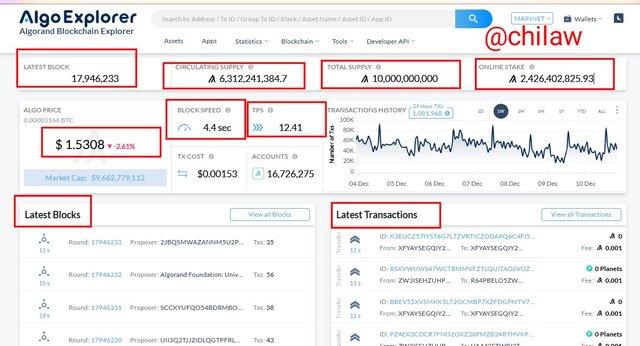
- Also From the landing overview we have the following information;
Lastest Block - 17,946,206
Circulating Supply - 6,312,241,384.7
Total Supply - 10,000,000,000
Online Stake - 2,426,402,825.93
ALGO price - $1.5318
Block Speed - 4.4sec
TPS - 12.41
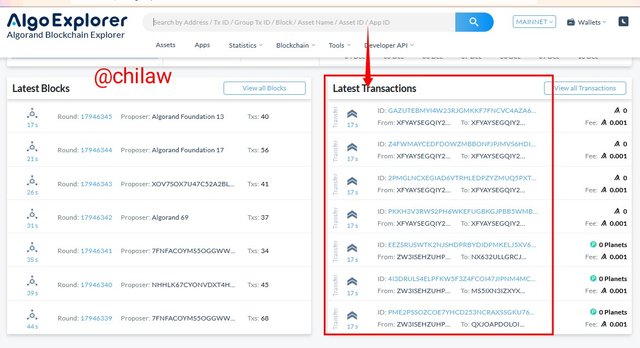
- To explore the ALGO transaction , click on any of the transaction IDs from the latest transaction
- The displayed interface shows the following details of the selected transaction ID.
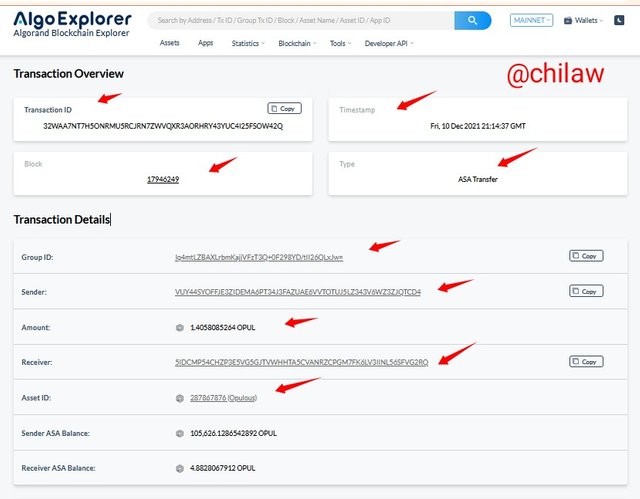
Transaction ID: 32WAA7NT7H5ONRMU5RCJRN7ZWVQXR3AORHRY43YUC4I25FSOW42Q
Timestamp: Fri, 10 Dec 2021 21:14:37 GMT
Block: 17946249
Type: ASA Transfer
Amount: 1.4058085264 OPUL
Receiver Copy: 5IDCMP54CHZP3E5VG5GJTVWHHTA5CVANRZCPGM7FK6LV3IINL56SFVG2RQ
Sender ASA Balance: 105,626.1286542892 OPUL
Receiver ASA Balance: 4.8828067912 OPUL

Carry out an analysis of the price of ALGO from the beginning of the year to the present. Via graphics (screenshots required.)

The price of ALGO as at the time of responding to this question task is $1.53 with a Market Cap of $9,657,595,339 and a circulating supply of 6.31B ALGO.
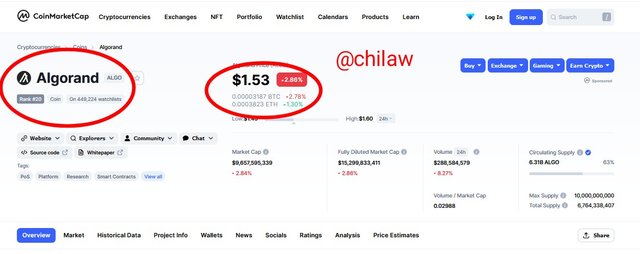
Price analysis as displayed in the chart shows that price got to its all-time High on 13th September 2022 with a Price value of $2.071 and Volume trade at $2.38B.
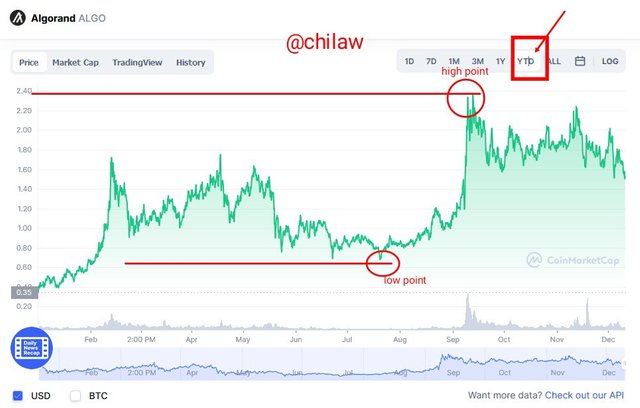
It was observed ascending from January where it was in its low. But after this, the price was at its lowest on 19th July 2021 where it was valued at $0.7484 with a volume trade of $62.96M

Conclusions

No doubts that Pure Proof of Stake (PPoS) was the first Blockchain consensus mechanism that was developed to conquer the Blockchain Trilemma in the Cryptocurrency space. It came with more Decentralization, Security, and Scalability in its protocol. By its workability allows more user participation where the required minimum scale to validate transaction greatly depends on the user's ability to hold the ALGO token.
This singular concept promotes a deeper decentralization in the Blockchain and as well as gives an additional security layer to the system and also scalability since there are more Validators to handle the required process.
Thank you professor @nane15 for the lessons.
Gracias.
All images used on this task are screenshots from algroexplorer site.